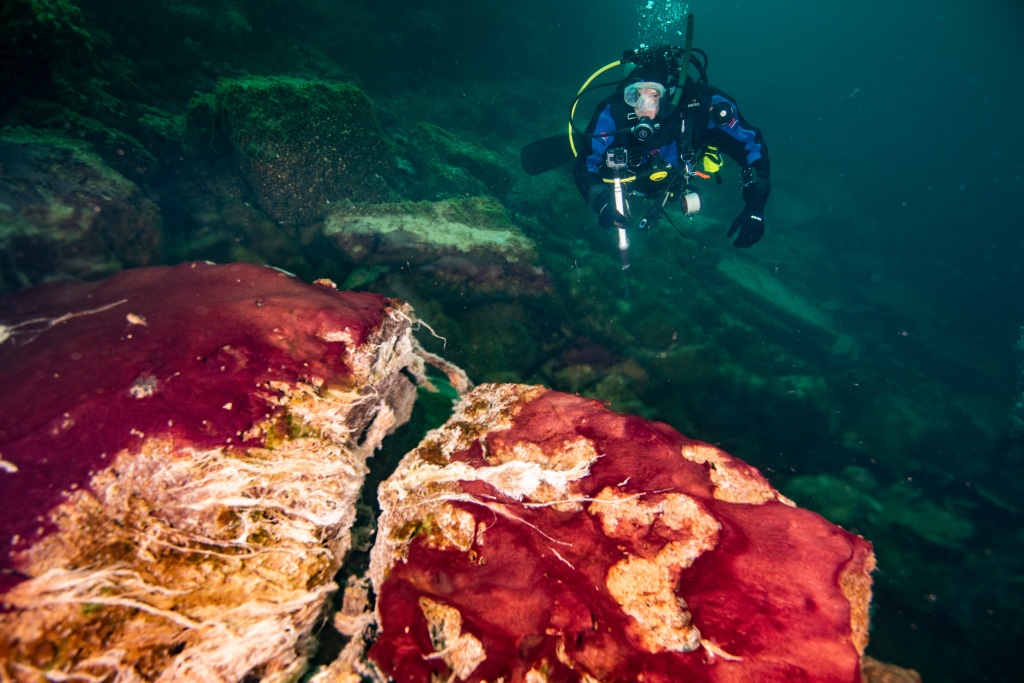When most people think of sinkholes, a massive cavity in the ground opening up and swallowing a car is what usually comes to mind. But when scientists at the NOAA Great Lakes Environmental Research Laboratory (GLERL) hear “sinkholes,” their minds jump to an unusual place — the bottom of a Great Lake.

Thousands of years ago, off the coast of Alpena, Michigan, patches of ground beneath Lake Huron collapsed to form a series of underwater sinkholes — some measuring hundreds of feet across and up to 60 feet deep. You may have read this NOAA.gov article about how these sinkholes are contributing water to Lake Huron, but did you know they also support a huge kingdom of microorganisms?
Microbes might be tiny, but they’re one of the biggest research topics in the Great Lakes. They thrive near the sinkholes because the groundwater seeping in has the perfect chemistry for their survival: low oxygen levels and lots of chloride and sulfate, which come from the dissolved limestone underlying the lake. These factors make the sinkholes inhospitable for fish and other wildlife normally found in the Great Lakes, which means these microbes have a much easier time surviving there than other creatures. With perfect living conditions and little competition, they’re so abundant that they form purple, green, and white microbial mats that cover the lake floor like a colorful carpet.

Scientists at GLERL are collaborating with partners from the University of Michigan and Grand Valley State University to see just what these microscopic lake dwellers can teach us. This video by Great Lakes Outreach Media highlights how they can even give us a deeper insight into the history of Earth itself.
Some sinkholes are so deep that sunlight can’t reach them, but that doesn’t stop some microbes from calling them home. They’re able to live their entire lives in complete darkness, because they get their energy from the added minerals in the water rather than from sunlight — a process called chemosynthesis. But whether they need sunlight or not, several of the microbial species present have proven to be full of surprises.
“In the near-shore systems, the cyanobacteria we found have DNA signatures that come closest to comparing to the cyanobacteria found at the bottom of a lake in Antarctica. So that’s a strange coincidence,” said Steve Ruberg, the scientist in charge of sinkhole research at GLERL. “Some of the other bacteria we’ve found in the deeper systems have only been found off the coast of Africa.”

The particular sinkholes we’re studying are located within NOAA’s Thunder Bay National Marine Sanctuary, an area of Lake Huron that’s federally protected for the purpose of preserving nearly 200 shipwrecks. In fact, the only reason we know about these sinkholes is because they were discovered by accident only 18 years ago, on a research cruise documenting the shipwrecks.

So why did this microbial paradise come into existence in the first place? The story goes back much further than the sinkholes’ discovery in 2001. About 400 million years ago, before the Great Lakes even existed, a layer of limestone bedrock formed beneath what is now Lake Huron. Then around 10,000 years ago, underground caves were created when a chemical reaction between the limestone and acidic groundwater dissolved away holes in the bedrock. All that was left were weakly supported “ceilings” that eventually collapsed into the sinkholes we — and the microbes — know and love today.

Since Lakes Michigan and Erie have the same limestone bedrock as Lake Huron, GLERL scientists think these lakes could be home to more of these fascinating underwater features. So while the excitement of this fieldwork has died down for the year, our research on Great Lakes sinkholes and their tiny inhabitants is far from over.

October 17, 2019 at 5:06 pm
This is quite an interesting story about microbes and how they can make energy in the absence of light by using minerals….wow that’s incredible when you think about it.
LikeLiked by 1 person
Pingback: Sinkhole Science: Groundwater in the Great Lakes | NOAA Great Lakes Environmental Research Laboratory